- ▶
- Heaters/Source
- ▶
- Agilent Heaters and SensorsMass Spectrometry, Scientific Supplies & ManufacturingScientific Instrument Services 5973 Source Heater Tamper Resistant Allen Wrench 5973/5975 Quad Sensor 5985 Source Heater Assembly Agilent Interface Heater Assembly 5971 Interface Heater

- ▶
- Reference Material on InstrumentationArticle - A High Temperature Direct Probe for a Mass Spectrometer Design of a Direct Exposure Probe and Controller for use ona Hewlett-Packard 5989 Mass Spectrometer SIS AP1000 AutoProbe™ SIS AP2000 AutoProbe™ - Description of System HPP7: Direct Probe Electronics Console HPP7: Direct Probe for the Agilent (HP) 5973/5975 MSD HPP7: HP Direct Probe Application Notes HPP7: Installation Directions for the Direct Probe HPP7: Side Cover for the HP 5973 MSD HPP7: Support HPP7: Probe Inlet System for the Agilent (HP) 5973 and 5975 MSD with Automatic Indexed Stops HPP7: Theory of Operation of the Direct Probe and Probe Inlet System Direct Thermal Extraction Thermal Desorption Application Notes Environmental Thermal Desorption Application Notes Food Science Thermal Desorption Application Notes Forensic Thermal Desorption Application Notes GC Cryo-Trap Application Notes Headspace Application Notes Purge & Trap Thermal Desorption Application Notes Theory of Operation of the AutoDesorb® System AutoDesorb Notes for SIS Dealers Adsorbent Resin Application Notes Installation of the Short Path Thermal Desorption System on Agilent (HP) and Other GCs Installation of the Short Path Thermal Desorption System on a Varian 3400 GC AutoDesorb® System Development Team Thermal Desorption Applications and Reference Materials Installation of the Short Path Thermal Desorption System - TD5 Part I - Design & Operation of the Short Path ThermalDesorption System Installation Instructions for the Model 951 GC Cryo-Trap on the HP 5890 Series GC Installation Instructions for the Model 961 GC Cryo-Trap on the HP 5890 Series GC Operation of the Model 951/961 GC Cryo-Trap SIS GC Cryo Traps - Theory of Operation NIST/EPA/NIH Mass Spectral Enhancements - 1998 version (NIST98) SIMION 3D Ion Optics Class Mass Spectrometer Source Cleaning Methods MS Tip: Mass Spectrometer Source Cleaning Procedures Mass Spec Source Cleaning Procedures Micro-Mesh® Abrasive Sheets Research Papers Using New Era Syringe Pump Systems EI Positive Ion Spectra for Perfluorokerosene (PFK) Cap Liner Information How do I convert between fluid oz and milliliters? Which bottle material should I choose? Which bottle mouth should I choose? The Bottle Selection Guide CGA Connections for Gas Tanks Chemical Reaction Interface Mass Spectrometry (CRIMS)

- TD
- ▶
- AccessoriesTD Supply Kit Desorption Tubes Adsorbent Resins Desorption Tube Needles Desorption Tube Seals Desorption System Fittings GC Cryo-Trap Extraction Cell TD Sample Loader Prepacked, Conditioned Desorption Tubes Desorption Tube Packing Accessories Stainless Steel Purge Heads Injection Port Liners Tenax TA Poster TD Application Notes Customer Service

- LiteratureApplication Notes Adsorbent Resins Guide Mass Spec Tips SDS Sheets FAQ MS Calibration Compound Spectra Manuals MS Links/Labs/ Organizations MS Online Tools Flyers on Products/Services Scientific Supplies Catalog About Us NextAdvance Bullet Blender® Homogenizer Protocols Micro-Mesh® Literature Instrumentation Literature Agilent GC/MS Literature SIS News / E-Mail Newsletter NIST MS Database - Update Notifications

- ▶
- Thermal Desorption Applications and Reference MaterialsDirect Thermal Extraction Headspace Environmental Food Science Applications Pharmaceuticals Forensic Note 103: EPA Method 325B, Novel Thermal Desorption Instrument Modification to Improve Sensitivity Note 102: Identification of Contaminants in Powdered Beverages by Direct Extraction Thermal Desorption GC/MS Note 101: Identification of Contaminants in Powdered Foods by Direct Extraction Thermal Desorption GC/MS Note 100: Volatile and Semi-Volatile Profile Comparison of Whole Versus Cracked Versus Dry Homogenized Barley Grains by Direct Thermal Extraction Note 99: Volatile and Semi-Volatile Profile Comparison of Whole vs. Dry Homogenized Wheat, Rye and Barley Grains by Direct Thermal Extraction GC/MS Note 98: Flavor and Aroma Profiles of Truffle Oils by Thermal Desorption GC/MS Note 97: Flavor Profiles of Imported and Domestic Beers by Purge & Trap Thermal Desorption GC/MS Note 95: Detection of Explosives on Clothing Material by Direct and AirSampling Thermal Desorption GC/MS Note 94: Detection of Nepetalactone in the Nepeta Cataria Plant by Thermal Desorption GC/MS Note 93: Detection of Benzene in Carbonated Beverages with Purge & Trap Thermal Desorption GC/MS Note 88: Analysis of Silicone Contaminants on Electronic Components by Thermal Desorption GC-MS Note 84: Vacuum Pump Exhaust Filters - Charcoal Exhaust Traps Note 83: Vacuum Pump Exhaust Filters - Oil Mist Eliminators Note 82: Vacuum Pump Exhaust Filters Note 80: Design, Development and Testing of a Microprocessor ControlledAutomated Short Path Thermal Desorption Apparatus Note 79: Volatile Organic Compounds From Electron Beam Cured and Partially Electron Beam Cured Packaging Using Automated Short Path Thermal Desorption Note 77: The Determination of Volatile Organic Compounds in VacuumSystem Components Note 75: An Apparatus for Sampling Volatile Organics From LivePlant Material Using Short Path Thermal Desorption Note 73: The Analysis of Perfumes and their Effect on Indoor Air Pollution Note 71: Flavor Profile Determination of Rice Samples Using Shor tPath Thermal Desorption GC Methods Note 65: Determination of Ethylene by Adsorbent Trapping and Thermal Desorption - Gas Chromatography Note 64: Comparison of Various GC/MS Techniques For the Analysis of Black Pepper (Piper Nigrum) Note 63: Determination of Volatile and Semi-Volatile Organics in Printer Toners Using Thermal Desorption GC Techniques Note 60: Programmable Temperature Ramping of Samples Analyzed ViaDirect Thermal Extraction GC/MS Note 57: Aroma Profiles of Lavandula species Note 55: Seasonal Variation in Flower Volatiles Note 54: Identification of Volatile Organic Compounds in Office Products Note 43: Volatile Organic Composition In Blueberries Note 42: The Influence of Pump Oil Purity on Roughing Pumps Note 41: Hydrocarbon Production in Pine by Direct Thermal Extraction Note 40: Comparison of Septa by Direct Thermal Extraction Note 39: Comparison of Sensitivity Of Headspace GC, Purge and Trap Thermal Desorption and Direct Thermal Extraction Techniques For Volatile Organics Note 38: A New Micro Cryo-Trap For Trapping Of Volatiles At the Front Of a GC Capillary Column Note 37: Volatile Organic Emissions from Automobile Tires Note 36: Identification Of Volatile Organic Compounds In a New Automobile Note 35: Volatile Organics Composition of Cranberries Note 34: Selection Of Thermal Desorption and Cryo-Trap Parameters In the Analysis Of Teas Note 33: Changes in Volatile Organic Composition in Milk Over Time Note 32: Selection and Use of Adsorbent Resins for Purge and Trap Thermal Desorption Applications Note 31: Volatile Organic Composition in Several Cultivars of Peaches Note 30: Comparison Of Cooking Oils By Direct Thermal Extraction and Purge and Trap GC/MS Note 29: Analysis Of Volatile Organics In Oil Base Paints By Automated Headspace Sampling and GC Cryo-Focusing Note 28: Analysis Of Volatile Organics In Latex Paints By Automated Headspace Sampling and GC Cryo-Focusing Note 27: Analysis of Volatile Organics In Soils By Automated Headspace GC Note 26: Volatile Organics Present in Recycled Air Aboard a Commercial Airliner Note 25: Flavor and Aroma in Natural Bee Honey Note 24: Selection of GC Guard Columns For Use With the GC Cryo-Trap Note 23: Frangrance Qualities in Colognes Note 22: Comparison Of Volatile Compounds In Latex Paints Note 21: Detection and Identification Of Volatile and Semi-Volatile Organics In Synthetic Polymers Used In Food and Pharmaceutical Packaging Note 20: Using Direct Thermal Desorption to Assess the Potential Pool of Styrene and 4-Phenylcyclohexene In Latex-Backed Carpets Note 19: A New Programmable Cryo-Cooling/Heating Trap for the Cryo-Focusing of Volatiles and Semi-Volatiles at the Head of GC Capillary Columns Note 18: Determination of Volatile Organic Compounds In Mushrooms Note 17: Identification of Volatile Organics in Wines Over Time Note 16: Analysis of Indoor Air and Sources of Indoor Air Contamination by Thermal Desorption Note 14: Identification of Volatiles and Semi-Volatiles In Carbonated Colas Note 13: Identification and Quantification of Semi-Volatiles In Soil Using Direct Thermal Desorption Note 12: Identification of the Volatile and Semi-Volatile Organics In Chewing Gums By Direct Thermal Desorption Note 11: Flavor/Fragrance Profiles of Instant and Ground Coffees By Short Path Thermal Desorption Note 10: Quantification of Naphthalene In a Contaminated Pharmaceutical Product By Short Path Thermal Desorption Note 9: Methodologies For the Quantification Of Purge and Trap Thermal Desorption and Direct Thermal Desorption Analyses Note 8: Detection of Volatile Organic Compounds In Liquids Utilizing the Short Path Thermal Desorption System Note 7: Chemical Residue Analysis of Pharmaceuticals Using The Short Path Thermal Desorption System Note 6: Direct Thermal Analysis of Plastic Food Wraps Using the Short Path Thermal Desorption System Note 5: Direct Thermal Analysis Using the Short Path Thermal Desorption System Note 4: Direct Analysis of Spices and Coffee Note 3: Indoor Air Pollution Note 2: Detection of Arson Accelerants Using Dynamic Headspace with Tenax® Cartridges Thermal Desorption and Cryofocusing Note 1: Determination of Off-Odors and Other Volatile Organics In Food Packaging Films By Direct Thermal Analysis-GC-MS

- Application NotesNote 103: EPA Method 325B, Novel Thermal Desorption Instrument Modification to Improve Sensitivity Note 102: Identification of Contaminants in Powdered Beverages by Direct Extraction Thermal Desorption GC/MS Note 101: Identification of Contaminants in Powdered Foods by Direct Extraction Thermal Desorption GC/MS Note 100: Volatile and Semi-Volatile Profile Comparison of Whole Versus Cracked Versus Dry Homogenized Barley Grains by Direct Thermal Extraction Note 99: Volatile and Semi-Volatile Profile Comparison of Whole vs. Dry Homogenized Wheat, Rye and Barley Grains by Direct Thermal Extraction GC/MS Note 98: Flavor and Aroma Profiles of Truffle Oils by Thermal Desorption GC/MS Note 97: Flavor Profiles of Imported and Domestic Beers by Purge & Trap Thermal Desorption GC/MS Note 96: Reducing Warping in Mass Spectrometer Filaments, with SISAlloy® Yttria/Rhenium Filaments Note 95: Detection of Explosives on Clothing Material by Direct and AirSampling Thermal Desorption GC/MS Note 94: Detection of Nepetalactone in the Nepeta Cataria Plant by Thermal Desorption GC/MS Note 93: Detection of Benzene in Carbonated Beverages with Purge & Trap Thermal Desorption GC/MS Note 92: Yttria Coated Mass Spectrometer Filaments Note 91: AutoProbe DEP Probe Tip Temperatures Note 90: An Automated MS Direct Probe for use in an Open Access Environment Note 89: Quantitation of Organics via a Mass Spectrometer Automated Direct Probe Note 88: Analysis of Silicone Contaminants on Electronic Components by Thermal Desorption GC-MS Note 87: Design and Development of an Automated Direct Probe for a Mass Spectrometer Note 86: Simulation of a Unique Cylindrical Quadrupole Mass Analyzer Using SIMION 7.0. Note 85: Replacing an Electron Multiplier in the Agilent (HP) 5973 MSD Note 84: Vacuum Pump Exhaust Filters - Charcoal Exhaust Traps Note 83: Vacuum Pump Exhaust Filters - Oil Mist Eliminators Note 82: Vacuum Pump Exhaust Filters Note 81: Rapid Bacterial Chemotaxonomy By DirectProbe/MSD Note 80: Design, Development and Testing of a Microprocessor ControlledAutomated Short Path Thermal Desorption Apparatus Note 79: Volatile Organic Compounds From Electron Beam Cured and Partially Electron Beam Cured Packaging Using Automated Short Path Thermal Desorption Note 78: A New Solution to Eliminate MS Down-Time With No-Tool-Changing of Analytical GC Columns Note 77: The Determination of Volatile Organic Compounds in VacuumSystem Components Note 76: Determination of the Sensitivity of a CRIMS System Note 75: An Apparatus for Sampling Volatile Organics From LivePlant Material Using Short Path Thermal Desorption Note 74: Examination of Source Design in Electrospray-TOF Using SIMION 3D Note 73: The Analysis of Perfumes and their Effect on Indoor Air Pollution Note 72: 1998 Version of the NIST/EPA/NIH Mass Spectral Library, NIST98 Note 71: Flavor Profile Determination of Rice Samples Using Shor tPath Thermal Desorption GC Methods Note 70: Application of SIMION 6.0 To a Study of the Finkelstein Ion Source: Part II Note 69: Application of SIMION 6.0 To a Study of the Finkelstein Ion Source: Part 1 Note 68: Use of a PC Plug-In UV-Vis Spectrometer To Monitor the Plasma Conditions In GC-CRIMS Note 67: Using Chemical Reaction Interface Mass Spectrometry (CRIMS) To Monitor Bacterial Transport In In Situ Bioremediation Note 66: Probe Tip Design For the Optimization of Direct Insertion Probe Performance Note 65: Determination of Ethylene by Adsorbent Trapping and Thermal Desorption - Gas Chromatography Note 64: Comparison of Various GC/MS Techniques For the Analysis of Black Pepper (Piper Nigrum) Note 63: Determination of Volatile and Semi-Volatile Organics in Printer Toners Using Thermal Desorption GC Techniques Note 62: Analysis of Polymer Samples Using a Direct Insertion Probe and EI Ionization Note 61: Analysis of Sugars Via a New DEP Probe Tip For Use With theDirect Probe On the HP5973 MSD Note 60: Programmable Temperature Ramping of Samples Analyzed ViaDirect Thermal Extraction GC/MS Note 59: Computer Modeling of a TOF Reflectron With Gridless Reflector Using SIMION 3D Note 58: Direct Probe Analysis and Identification of Multicomponent Pharmaceutical Samples via Electron Impact MS Note 57: Aroma Profiles of Lavandula species Note 56: Mass Spec Maintenance & Cleaning Utilizing Micro-Mesh® Abrasive Sheets Note 55: Seasonal Variation in Flower Volatiles Note 54: Identification of Volatile Organic Compounds in Office Products Note 53: SIMION 3D v6.0 Ion Optics Simulation Software Note 52: Computer Modeling of Ion Optics in Time-of-Flight mass Spectrometry Using SIMION 3D Note 51: Development and Characterization of a New Chemical Reaction Interface for the Detection of Nonradioisotopically Labeled Analytes Using Mass Spectrometry (CRIMS) Note 50: The Analysis of Multiple Component Drug Samples Using a Direct Probe Interfaced to the HP 5973 MSD Note 49: Analysis of Cocaine Utilizing a New Direct Insertion Probe on a Hewlett Packard 5973 MSD Note 48: Demonstration of Sensitivity Levels For the Detection of Caffeine Using a New Direct Probe and Inlet for the HP 5973 MSD Note 47: The Application Of SIMION 6.0 To Problems In Time-of-Flight Mass Spectrometry Note 46: Delayed Extraction and Laser Desorption: Time-lag Focusing and Beyond Note 45: Application of SIMION 6.0 to Filament Design for Mass Spectrometer Ionization Sources Note 44: The Design Of a New Direct Probe Inlet For a Mass Spectrometer Note 43: Volatile Organic Composition In Blueberries Note 42: The Influence of Pump Oil Purity on Roughing Pumps Note 41: Hydrocarbon Production in Pine by Direct Thermal Extraction Note 40: Comparison of Septa by Direct Thermal Extraction Note 39: Comparison of Sensitivity Of Headspace GC, Purge and Trap Thermal Desorption and Direct Thermal Extraction Techniques For Volatile Organics Note 38: A New Micro Cryo-Trap For Trapping Of Volatiles At the Front Of a GC Capillary Column Note 37: Volatile Organic Emissions from Automobile Tires Note 36: Identification Of Volatile Organic Compounds In a New Automobile Note 35: Volatile Organics Composition of Cranberries Note 34: Selection Of Thermal Desorption and Cryo-Trap Parameters In the Analysis Of Teas Note 33: Changes in Volatile Organic Composition in Milk Over Time Note 32: Selection and Use of Adsorbent Resins for Purge and Trap Thermal Desorption Applications Note 31: Volatile Organic Composition in Several Cultivars of Peaches Note 30: Comparison Of Cooking Oils By Direct Thermal Extraction and Purge and Trap GC/MS Note 29: Analysis Of Volatile Organics In Oil Base Paints By Automated Headspace Sampling and GC Cryo-Focusing Note 28: Analysis Of Volatile Organics In Latex Paints By Automated Headspace Sampling and GC Cryo-Focusing Note 27: Analysis of Volatile Organics In Soils By Automated Headspace GC Note 26: Volatile Organics Present in Recycled Air Aboard a Commercial Airliner Note 25: Flavor and Aroma in Natural Bee Honey Note 24: Selection of GC Guard Columns For Use With the GC Cryo-Trap Note 23: Frangrance Qualities in Colognes Note 22: Comparison Of Volatile Compounds In Latex Paints Note 21: Detection and Identification Of Volatile and Semi-Volatile Organics In Synthetic Polymers Used In Food and Pharmaceutical Packaging Note 20: Using Direct Thermal Desorption to Assess the Potential Pool of Styrene and 4-Phenylcyclohexene In Latex-Backed Carpets Note 19: A New Programmable Cryo-Cooling/Heating Trap for the Cryo-Focusing of Volatiles and Semi-Volatiles at the Head of GC Capillary Columns Note 18: Determination of Volatile Organic Compounds In Mushrooms Note 17: Identification of Volatile Organics in Wines Over Time Note 16: Analysis of Indoor Air and Sources of Indoor Air Contamination by Thermal Desorption Note 14: Identification of Volatiles and Semi-Volatiles In Carbonated Colas Note 13: Identification and Quantification of Semi-Volatiles In Soil Using Direct Thermal Desorption Note 12: Identification of the Volatile and Semi-Volatile Organics In Chewing Gums By Direct Thermal Desorption Note 11: Flavor/Fragrance Profiles of Instant and Ground Coffees By Short Path Thermal Desorption Note 10: Quantification of Naphthalene In a Contaminated Pharmaceutical Product By Short Path Thermal Desorption Note 9: Methodologies For the Quantification Of Purge and Trap Thermal Desorption and Direct Thermal Desorption Analyses Note 8: Detection of Volatile Organic Compounds In Liquids Utilizing the Short Path Thermal Desorption System Note 7: Chemical Residue Analysis of Pharmaceuticals Using The Short Path Thermal Desorption System Note 6: Direct Thermal Analysis of Plastic Food Wraps Using the Short Path Thermal Desorption System Note 5: Direct Thermal Analysis Using the Short Path Thermal Desorption System Note 4: Direct Analysis of Spices and Coffee Note 3: Indoor Air Pollution Note 2: Detection of Arson Accelerants Using Dynamic Headspace with Tenax® Cartridges Thermal Desorption and Cryofocusing Note 1: Determination of Off-Odors and Other Volatile Organics In Food Packaging Films By Direct Thermal Analysis-GC-MS Tech No. "A" Note 14: Elimination of "Memory" Peaks in Thermal Desorption Improving Sensitivity in the H.P. 5971 MSD and Other Mass Spectrometers - Part I of II Improving Sensitivity in the H.P. 5971 MSD and Other Mass Spectrometers- Part II of II Adsorbent Resins Guide Development and Field Tests of an Automated Pyrolysis Insert for Gas Chromatography. Hydrocarbon Production in Pine by Direct Thermal Extraction A New Micro Cryo-Trap for the Trapping of Volatiles at the Front of a GC Capillary (019P) - Comparison of Septa by Direct Thermal Extraction Volatile Organic Composition in Blueberry Identification of Volatile Organic Compounds in Office Products Detection and Indentification of Volatiles in Oil Base Paintsby Headspace GC with On Column Cryo-Trapping Evaluation of Septa Using a Direct Thermal Extraction Technique INFLUENCE OF STORAGE ON BLUEBERRY VOLATILES Selection of Thermal Desorption and Cryo-Trap Parameters in the Analysis of Teas Redesign and Performance of a Diffusion Based Solvent Removal Interface for LC/MS The Design of a New Direct Probe Inlet for a Mass Spectrometer Analytes Using Mass Spectrometry (CRIMS) Application of SIMION 6.0 to Filament Design for Mass Spectrometer Ionization Sources A Student Guide for SIMION Modeling Software Application of SIMION 6.0 to Problems in Time-of-flight Mass Spectrometry Comparison of Sensitivity of Headspace GC, Purge and TrapThermal Desorption and Direct Thermal Extraction Techniques forVolatile Organics The Influence of Pump Oil Purity on Roughing Pumps Analysis of Motor Oils Using Thermal Desorption-Gas Chromatography-Mass Spectrometry IDENTIFICATION OF VOLATILE ORGANIC COMPOUNDS IN PAPER PRODUCTS Computer Modeling of Ion Optics in Time-of-Flight mass Spectrometry using SIMION 3D Seasonal Variation in Flower Volatiles Development of and Automated Microprocessor Controlled Gas chromatograph Fraction Collector / Olfactometer Delayed Extraction and Laser Desorption: Time-lag Focusing and Beyond A New Micro Cryo-Trap for the Trapping of Volatiles at the Front of a GC Column Design of a Microprocessor Controlled Short Path Thermal Desorption Autosampler Computer Modeling of Ion Optics in Time-of-Flight Mass Spectrometry Using SIMION 3D Thermal Desorption Instrumentation for Characterization of Odors and Flavors

- ▶
- Note 73: The Analysis of Perfumes and their Effect on Indoor Air Pollution (This Page)
Presented at EAS, Somerset, NJ., November 1998
INTRODUCTION
The quality of indoor air has become a major concern to the entire population and numerous reports have described the "sick building syndrome" which has been associated with the quality of indoor air in public buildings. Building environment related health problems may be due to contamination of indoor air by emissions of volatile organic compounds (VOC's) from a variety of sources including construction materials, fabrics, furnishings, maintenance supplies, adhesives, paints, caulks, paper, cleaning products, foods and perfumes. Because many of the volatile emissions and by-products from these products are toxic, or individuals have become sensitized to them, additional knowledge of the levels of these organic chemicals in the indoor air environment is required in order to determine their human health impact. New methods are required to accurately determine the identity and to accurately quantify the levels of these volatile organics in indoor air, and additional studies will be needed to determine the sources of the air contamination.
In this study, several perfumes were analyzed using a Short Path Thermal Desorption system connected to the injection port of a GC/MS system. The goal was to determine the identity and range of volatile organic compounds present in the perfume samples and to determine the degree to which these organic compounds are emitted into the atmosphere. The main purpose of this paper is to develop methods to permit the detection and identification of the components from perfumes in indoor air.
Equipment
Gas Chromatograph/Mass Spectrometer System. All identification was accomplished using a HP 6890 GC, interfaced to a HP 5973 Mass Spectrometer. The GC injection port temperature was at 250 °C and the GC/MS transfer line was at 250 °C. A Hewlett-Packard HP-35MS, 0.25mm x 0.25µ x 60m GC capillary column was programmed with an initial temp of 50 °C to a temp of 200 °C at 1 degrees per minute, then to 280°C at 3 degrees per minute, and finally held at 280°C for 5 minutes (total analysis time 182 minutes). This long GC run was required in order to separate and resolve the 400+ compounds present in many of the perfumes. Carrier gas flow was 0.90 ml per min of He. During the thermal desorption process, the sample was split 10:1 to reduce the sample volume introduced into the GC column. The HP 5973 MSD was operated in the Electron Impact Mode (EI), and scanned over the mass range of 35 to 450 Daltons. All analytes were identified using the Hewlett Packard ChemStation software with the Wiley NBS mass spec library as well as via the NIST AMDIS software using the NIST mass spec library. Analytes were identified only if a match quality was achieved.
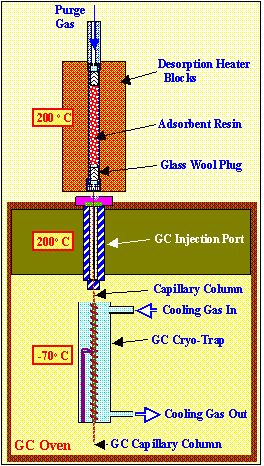
Figure # 1 - Theory of Operation of Short Path Thermal Desorption System
Thermal Desorption System
The Scientific Instrument Services Short Path Thermal Desorption System (SPTD), Model TD4 (Figure # 1), was used for all analysis. The thermal desorption system blocks were temperature programmed from 150 to 270 °C at 40 degrees per minute. The total thermal desorption time was 6.0 minutes for all analysis.
GC Micro Cryo Trap
A Scientific Instrument Services GC Micro Cryo-Trap (Figure # 1) was placed at the front of the GC column in order to improve GC peak resolution. During the injection phase, the cryo-trap used liquid CO2 to freeze the analytes at the front of the GC column at -65 °C. After injection was complete, the cryo-trap was heated to 250 °C to release the analytes for analysis.
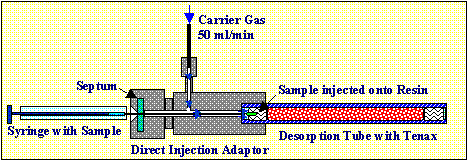
Figure # 2 - Using the Direct Injection Adaptor to Load Perfume Samples onto a Desorption Tube
Direct Injection Adaptor
The SIS Direct Injection Adaptor (Figure # 2) was used to prepare the liquid samples for analysis. This system permits the liquid samples to be injected via a standard GC syringe directly onto the Tenax® bed in the desorption tube. A carrier gas purge carries the volatiles from the sample onto the Tenax to eliminate any sample loss due to evaporation. Subsequent purging of the Tenax bed with 500 milliliters of helium, removes the ethanol from the sample, while leaving the other analytes trapped on the resin bed.
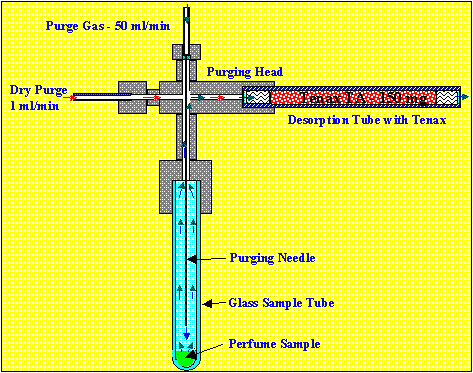
Figure # 3 - Purging Perfume Samples for Volatiles
Purge and Trap System
This apparatus (Figure # 3) consists of a sparge gas inlet connected to a stainless steel purging needle that is inserted through an adaptor fitting into a 5 ml test tube. A dry purge gas inlet is located at a right angle to the sparge gas inlet at the top of the apparatus. Opposite the dry purge inlet is the connector for the glass-lined stainless steel (GLT) desorption tube containing the adsorbent resin. The glass sample tube was placed into a temperature controlled hot water bath to control the sampling temperature. Samples for analysis are injected into the bottom of the disposable glass sampling tube using a 10 ul GC syringe.
Experimental
Determination of Volatiles and Semi-volatiles in Perfumes
Thermal desorption tubes were packed with 150 mg of Tenax TA, and conditioned at 300 °C for 2 hours. A syringe was used to inject 1.0 ul of the liquid perfume onto the front of the adsorbent resin bed using the SIS Direct Injection Adaptor (Figure # 2). This injection port type device permits the liquid sample to be injected onto the Tenax trap with no sample loss. The Tenax trap with the sample was then purged with 500 ml of helium gas to remove the ethanol (the major component in the perfumes) from the sample. The desorption tube containing the sample was then removed from the Direct Injection Adaptor and was attached to the Short Path Thermal Desorption System (Figure # 1), purged for 3.0 minutes and then was thermally desorbed into the GC injection port using the temperature program described above. The desorbed analytes were cryo focused at the front of the GC column using the Cryo-Trap at a temperature of -65 °C during the thermal desorption cycle, after which the cryo trap was rapidly heated to 250 °C to release the volatile for analysis via the GC program described above. The GC was temperature programmed as described above and the resulting peaks were identified using the mass spectrometer, software and data libraries described previously. Six different manufacturers perfumes were analyzed in this manner and the results are shown in Figure # 4. Four of the perfumes (C1, C2, C3 and C4) are from the same distributor or manufacturer. The other two perfumes (A1 and B1) are from unrelated companies.
Purging of Perfumes as a Function of Temperature
In order to determine the volatiles and semi-volatiles that are emitted into the atmosphere from perfumes at room temperature and body surface temperature, the SIS Purge and Trap System was used (Figure # 3). A 1.0 ul sample of perfume samples was injected into a 5.0 ml disposable test tube. Two perfume manufacturers (A1 and B1) were used in this study. Each perfume was set up 6 times for each of the 6 temperature studies required for each perfume. This test tube with the perfume sample was connected to the purge and trap system and a preconditioned thermal desorption tube with 150 mg of Tenax TA was attached. The sample tube was placed into a hot water bath at a set temperature (20, 30, 40, 50, 60 and 70°C temperatures were used for this study) and purged with helium gas at 50 ml per minute for 10.0 minutes. This is a total gas volume of 500 ml which is 100 times the test tube sample volume. The purged analytes were trapped on the Tenax desorption trap which was subsequently analyzed as described above. The results from perfume A1 and B1are reported (Figure # 5 and Figure # 7).
Residue after Evaporation of Perfumes
In order to determine what remains on the skin or surface after a perfume sample has evaporated, samples of perfumes were evaporated down in volume. This was accomplished by weighing 3.0 grams of the perfume into a 50 ml beaker and passing an air stream (50 ml/minute) over the surface of the sample at room temperature. After the sample has sufficiently evaporated down in volume, the weight loss was measured and the degree of evaporation was calculated. The perfume samples are greater than 80% ethanol which was readily evaporated off at room temperature. In order to obtain samples that were more than 90% evaporated, it was necessary to heat the sample on a hot plate during the evaporation process. After evaporation was complete, the liquid residue was then taken back up to volume (3.0 gram) with methanol solvent and 1.0 ul of the sample was injected in the Tenax desorption tubes and analyzed using the SIS Direct Injection Adaptor (Figure # 2) technique described above.
Internal Standard Quantitation. In order to determine the semi-quantitative amounts of the various analytes in the perfume samples, an internal standard was injected into the Tenax desorption tube before the samples were collected. The internal standard was prepared by diluting 5.0 mg of d8-naphthalene to 50 ml with methanol. This produce a solution of the d8-naphthalene of 1.0 ng/ul. Then 4.0 ul of this solution (400 ng of d8-naphthalene) was injected into the Tenax desorption tube and purged with 100 ml of helium to remove the methanol solvent. The amounts of the various analytes present in each of the perfumes (Conc-A) were determined by dividing the area of the analyte peak (Area-A) by the area of the d8-naphthalene internal standard (Area-S) and then multipling this by the concentration of the d8-naphthalene (Conc-S) divided by the volume of perfume injected (Perf-V). The results are expressed in ng/ul or assuming a density of 1.0 for the perfumes can also be represented as parts per million (ppm).
Conc-A = (Area-A / Area-S) X (Conc-S / Perf-V)These results are only semi-quantitative due to this method of quantitation. Errors of 100 % or more in the amounts of the analytes identified are possible.
Discussion
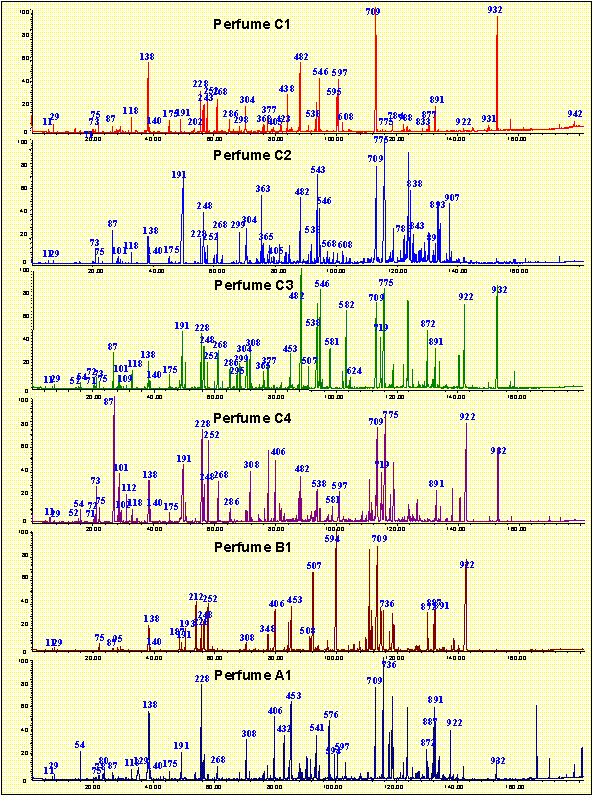
Figure # 4 - Analysis of Perfumes for Volatile Organics - Index to Peak Identification.
Figure 4 shows the volatile and semi volatile organics present in the 6 different perfumes. Using the HP ChemStation software more than 200 anlaytes of various concentrations were detected in each sample of which about 150 analytes were identified using the Hewlett Packard ChemStation software with the Wiley NBS and NIST libraries. Additional analysis of the data using the NIST AMDIS software was able to resolve more than 400 components in each of the perfume samples of which about 250 were able to be identified via library searches using the NIST98 software and NIST database. The increased number of peaks detected in each chromatogram is due to the ability of the NIST software to deconvolute or separate multiple components in a single chromatograph peak and the automatic subtraction of background noise from the mass spectrum of the analyte of interest. The analysis of each perfume identified a large number of terpenes, sesquiterpenes, phenols, esters, aldehydes and benzene deritives. There were few volatile organics detected, which would rapidly evaporate from the sample at room temperature, other than ethanol, the solvent base for the perfume. There were a large number of terpenes (MW = 136) and sesquiterpines (MW = 204) present in the perfumes. The mass spectrum of these compounds are very similar, therefore the identification of many of the compounds identified are subject to error. There were many terpenes and sesquiterpenes which are labeled as unknown or unknown terpine, because a good mass spectrometer identification was not possible. The compounds detected range from small volatiles (i.e Acetic Acid (#11), MW = 60) to large semi-volatile organics (i.e. Squalene (#942), MW = 410). Each of the perfumes has a distinct pattern of organics that is different from the other perfumes. In total more than 800 different analytes were detected in the 6 perfume samples analyzed. This distinct pattern for a particular perfume could easily be adapted into a quality control method or could be used to identify a particular perfume.
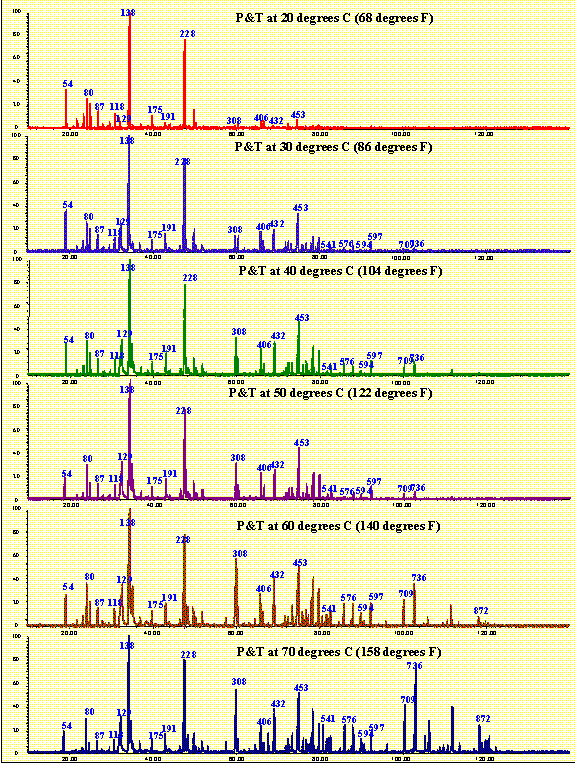
Figure # 5 - Purging Perfume A1 at Different Temperatures
Two perfumes were next analyzed to determine the volatiles that are emitted into the atmosphere when the perfume is placed on a surface such as the skin. As described previously, 1.0 ul of the perfumes were injected into the P&T system, the volatiles purged off the glass surface at various temperatures. Each sample was purged with a gas volume of 100 times the sample vial volume, to simulate the exposure of the perfume on the skin and then analyzed as described. The results of the analysis of perfume A1 are shown in Figure # 5 and Perfume B1 are shown in Figure # 7. At room temperature, only a few of the terpenes and more volatile organics were detected. As the temperature of the sample was increased, the range of volatiles purged into the air stream increased in molecular weight. However to purge many of the higher molecular weight compounds including Diethylphthalate (#709) required temperatures much higher than the normal skin temperature. Several of the analytes present in the perfume, were of insufficient volatility to be purged off the surface unless the temperature was increased above 60 degrees C and therefore would not be expected to contribute to the volatiles in indoor air. Index to peak identification.
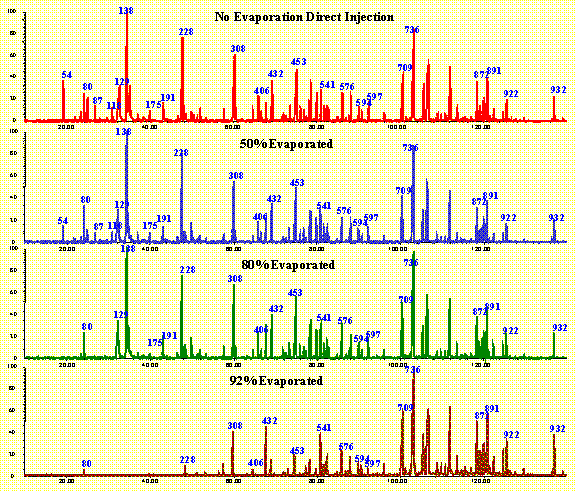
Figure # 6 - Residue Remaining in Perfume A1 After Evaporation
In the related study, samples of the perfumes were evaporated under a stream of air, and the remaining residue was analyzed (Figure # 6). When the sample was reduced by 50% to 80% of the original volume, the composition of the perfume was basically unchanged. This reduction in volume was due almost entirely to the ethanol solvent used to dilute the perfume. In order to reduce the perfume by 92% of the original volume, the sample was heated slightly on a hot plate. At this point many of the low end volatiles were reduced or purged off completely. These were the same compounds that were purged off and detected at Purge and Trap Temperatures of 30 and 40 degrees C in the previous study.
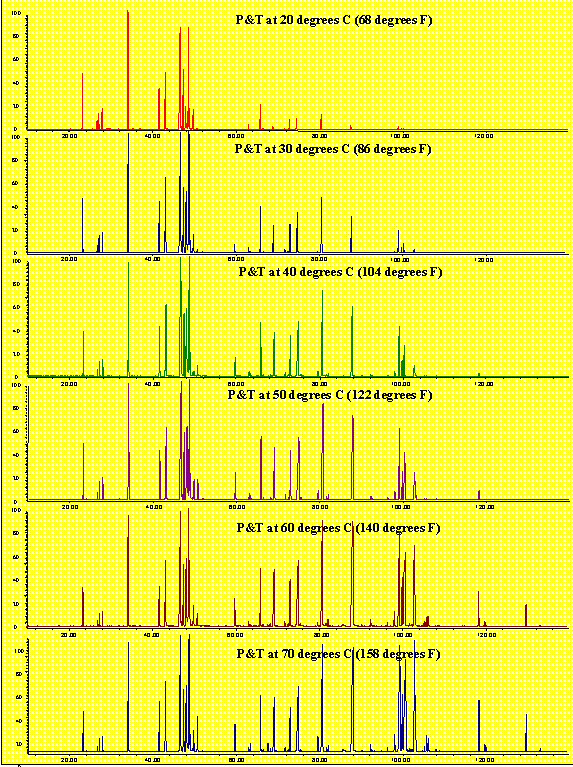
Figure # 7 - Analysis of Perfume B1 as a Function of Temperature
Conclusion
The Short Path Thermal Desorption used in conjunction with a GC/MS system proved to be a useful technique for the determination of the analytes present in perfume samples that can contribute to the quality of indoor air. The Direct Injector Adaptor was used to collect the volatiles directly from liquid samples for analysis and the subsequent detection and identification of all the analytes present in each sample. The Purge and Trap system was used to determine the range of analytes that would be evaporated from the perfume samples into the air. In this study 6 different perfumes were analyzed. Each of the perfumes has a distinct pattern of organics that is different from the other perfumes. In total more than 800 different analytes were detected in the 6 perfume samples analyzed. The volatile organics present in these perfumes can contribute to indoor air pollution. The perfumes are normally applied to the skin and thereby contribute to the aroma for which the perfume has been designed, but they also contribute to the overall composition of the environment air in a closed building. The techniques described above can be used to further study the potential problems of perfumes on the quality of indoor air. The techniques could also be used as a quality control method for manufacture of perfume or as a method for the identification of a particular perfume or manufacturer. The method can also be used to quantitate each of the anlaytes in a perfume sample by injecting an internal standard into the samples before analysis. Semi-quantitative analysis of each of the perfumes listed above has been done.
Disclaimer
This article is only meant to describe methods that could be used to analyze perfumes and the techniques that could be used to determine the volatile organics that can be volatilized from perfumes into indoor air. The information and data published is informational only. The results published above are not all inclusive and the identification of any components in the described samples may not be correct since standards were not run with the samples and the identification was based solely on the Wiley and NIST mass spec libraries. Scientific Instrument Services accepts no responsibility and does not assume any liability for the accuracy of any of the published data. Scientific Instrument Services and the authors do not imply that any particular analyte present in the perfume samples studied is a health hazard or presents any hazard in its occurrence in indoor air in a confined space.
Appendix
Index to Compounds in Perfumes
The following is a list of the compounds detected and identified in
the 6 perfumes analyzed in this study. More than 800 compounds were detected
but only the analytes with a siznificant presence and that could be identified
with a quality match of 800 (based on 1000 for a perfect match) or better
are listed. Even so, with the similar chemical structure of many compounds,
as the terpenes and sesquiterpenes, the identification may not be accurate.
None of the anlaytes were individually analyzed and the identification
was based strictly based on mass spectrometer library searches from the
Wiley and Nist mass spec databases. Therefore the following compounds are
being listed as tentatively identified and all results are subject to error.
| 7.
Isopropyl alcohol
8. 2-Methyl-3-Buten-2-ol 9. Acetone 10. n-Butanol 11. Acetic Acid 52. a -Phellandrene 54. a-Pinene 71. 3-Methyl-2-Buten-1-ol acetate 72. b-Phellandrene 73. b-Pinene 75. b-Myrcene 78. 2-Methyl-2-octanol 80. 3-Carene 87. Limonene 95. 3,7-Dimethyl-1,3,6-Octatriene 101. p-Cymene 102. Eucalyptol 109. Benzaldehyde 118. 1-Methoxy-4-methyl benzene 128. Linaloloxide 129. 1,1'-Oxybis-2-propanol 138. b-Linalool 140. Benzyl alcohol 175. Benzoic Acid, methyl ester 187. 3,7-Dimethyl-1,6-Nonadien-3-ol 191. Phenethyl alcohol 193. 3,7-Dimethyl-1,6-Nonadien-3-ol 202. Decanal 212. a-Terpineol 228. Acetic Acid, phenylmethyl ester 229. Unknown Hydroxyterpine (MW=154) 243. 3,7-Dimethyl-6-Octen-1-ol 245. Internal Standard - d8-naphthalene 248. 1-Isopropyl-3-Tert-Butylbenzene 250. 3,7-dimethyl-2,6-Octadien-1-ol 252. 3,7-Dimethyl-1,6-octadien-3-ol-2-aminobenzoate 260. 3,7-Dimethyl-3,6-Octadien-1-ol 268. 3,7-Dimethyl-2,6-octadien-1-ol 270. 3,7-Dimethyl-2,6-octadienal 286. Benzenepropanol 295. Acetic Acid, phenylethyl ester 298. Cyclododecanone 299. 2-Butyl-2-octenal 304. 7-Hydroxy-3,7-dimethyl octanal 308. a,a-dimethylbenzeneethanol acetate
|
309.
3,7-Dimethyl-6-Octen-1-ol acetate
348. 3,7-dimethyl-2,6-Octadien-1-ol acetate 365. 2-Butyl-2-octenal 368. Caryophyllene 377. 3-Phenyl-2-propen-1-ol 405. Eugenol 406. 3-Allyl-6-methoxyphenol 423. 1,1-Diethoxy-decane 432. 2-Amino Benzoic Acid, methyl ester 438. a-Ionone 453. Piperonal 482. a-Isomethyl ionone 507. b-Methylionone 508. 4-[1,1-Dimethylethyl]-a-methyl-benzeneethanol 538. Vanillin 541. 7-Diethoxymethylbicyclo[3.2.0]heptan-2-one 543. 7-Diethoxymethylbicyclo[3.2.0]heptan-2-one 545. Unknown 546. 1-(2,6,6-Trimethyl-2-cyclohenen-1-yl)-Penten-3-one 568. Methyl-a-ionone 576. 1-Methoxy-4-pentyl-benzene 581. Ethyl Vanillin 582. Amyl Silicylate 594. Lillal 595. 1,2-dimethoxy-4-(2-propenyl) benzene 597. 2H-1-Benzopyran-2-one 608. b-Methylionone 624. Rose acetate 709. Diethyl Phthalate 719. Salicylic acid, 3 hexenyl ester 736. Methyl dihydrojasmonate 775. Methyl dihydrojasmonate 784. 3,7,11,15-Tetramethyl-2-hexadecen-1-ol 788. Isopropyl Myristrate 833. Nonadecane 838. 2-Phenyl benzoxazole 843. 1-Ethyl-3-propyl-5-(propene-1-yl)adamantane 872. 2-Hydroxy-cyclopentadecanone 877. 3-Methyl-cyclopentadecanone 887. Galoxolide 891. Benzyl benzoate 893. Hexadecanoic acid, methyl ester 907. Dehydro Aromadendrene 922. Benzyl salicylcate 932. Musk ketone 942. Squalene |

